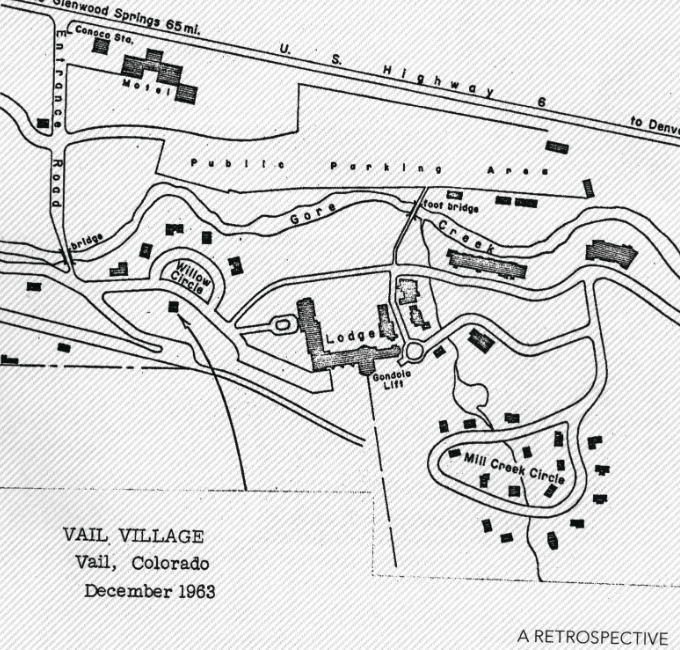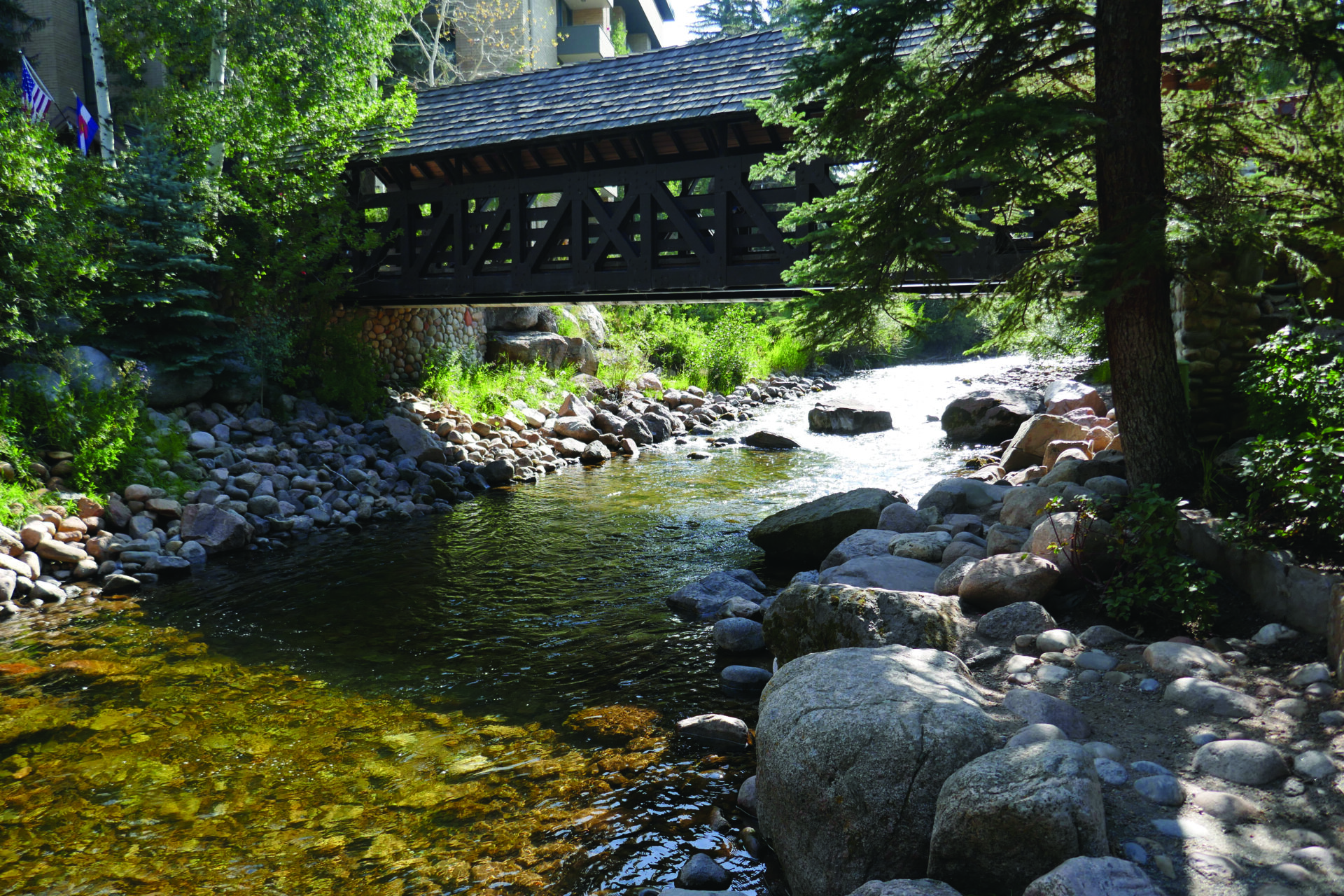If you’re a first-time or frequent visitor to Vail Village or a full-time local resident, there’s no doubt you’ve crossed the familiar Covered Bridge more times than you’d remember, passing over Gore Creek to the legendary Bridge Street. A lode of local history surrounds this famous landscape. In 1962 at age 11, I first skipped across the open bridge floorboards. Recently at age 70, I strolled in the shadows beneath its peaked roof and admired Vail Mountain.

Early Bridge Street Image from Vail 50.
For this debut issue of Covered Bridge, which celebrates Vail lifestyle both past and present, we thought it fitting and fun to delve into the story of the first street in Vail and its famous landmarks. Piecing that together proved a challenge and more fascinating than expected. Most folks involved in the original conception and construction of the early town are no longer here to share their experiences. But, those who remain fondly reminisce about the wisdom, vision, grit and with that built a place “like nothing on Earth.”
In the beginning, there was a pristine creek. On its north side, a two-lane highway and a new gravel parking lot. On its south side, a dirt roadway that led up to a magnificent mountain showcasing few fresh-cut trails. In 1961, before skiing began, early Vail resident and Milwaukee architect, Fitzhugh Scott, built the first single-family home on Mill Creek Circle — nearly a suburb! Scott also designed the famous curved layout for the length of the Bridge Street roadway, forever lending curiosity about what one might discover around the corner. Maybe the movie Psycho playing on a sheet inside the Gondola Building? True!
December 15, 1962. Vail Mountain Opening Day. A simple, uncovered bridge provided access from parking to the primitive street. Vail had one gondola, two chairlifts, three lodges and two retail shops (Blanche Ski Shop and a second ski rental shop). It was impossible to schlep skis from car to gondola in ski boots without tracking mud. And where is the restroom? Is there any coffee?
Blink … and change begins along the street. During the first two years, a few buildings rose up. Most notable, the signature Clock Tower. In 1962, John McBride bought the future Gorsuch site, with his vision to build a clock tower in the center of town. The original two-story structure (1963) stood smaller than the current tower, but became an obvious village icon.
In May 1962, Rod Slifer arrived from Aspen at the encouragement of colleague and friend, Morrie Shepard, to explore the fledgling ski town. (Shepard had directed the Aspen Ski School; by 1964, he gathered 42 instructors to form Vail’s own). Slifer became an early employee of Vail Associates in 1962, hired as “clerk in the works” when the Bridge Chalet, Vail’s first building, housed the company’s headquarters. He scraped together the resources to purchase a lot on Bridge Street next to McBride’s. Construction for the first phase of his building began the following year. His office at Slifer Smith & Frampton Real Estate remains in that location today.
Slifer remembers the “gap” between his property and his neighbor’s, a small triangular open space where he sold Christmas trees for several seasons. “That was a good business!” he laughs.
Bridge Street quickly grew into a busy street where Alpine village ambiance prevailed, completely by design! The “funny-talking” people who arrived in early Vail from Austria, Switzerland, Germany and other classic ski destinations were set on creating a European prototype as their new home.
Welcome The Red Lion, February 1963. Larry and Marge Burdick, owners and operators of the downstairs restaurant/bar, moved in upstairs with their family of seven kids. Finding suitable housing was a difficult priority in early Vail, too! Maximizing space was the rule.
But now, skiers returning from the slopes had a place to stop for refreshment, including coffee!
Across the street, Dick Hauserman introduced his two-story Plaza Building with retail shops on the street-level and simple hotel rooms and apartments above. Hauserman provided upstairs living space for himself and wife, Blanche (aka Christie Hill). Christie was responsible for a second adjacent building with a residence on top, opening her Blanche Ski Shop retail space below — the future Christy Sports.
In December 1964, directly across from the Clock Tower, an authentic Austrian-style lodge opened with Bavarian music, goulash and dumplings, sauerkraut and strudel. (I remember opening night!) The Gasthof Gramshammer, owned by world-class ski racer, Pepi Gramshammer, and his glamorous wife, Sheika, offered comfortable rooms and tasty cuisine. Luckily, a proper liquor license soon followed. Pepi’s Bar, “Dahling” — Sheika’s nightclub, the gourmet Antlers Room and Pepi’s Sports all comprise the history of this famous hotel. Vail wouldn’t be the same if Bob Parker, Dick Hauserman and Morrie Shepard hadn’t lured Pepi from Sun Valley, and if Sheika hadn’t joined her new husband from Aspen. Today, poke into the Gasthof to enjoy photos of the many rich and famous who have bellied up to the Bar or hobnobbed on the Porch.
Also in 1964, The Casino arrived. Owner/builder, Bill Whiteford (an early Vail investor), modeled the unique venue after his favorite casino in Kitzbuehl, the Austrian village next to Pepi’s native Kufstein! Ironically, Whiteford’s garish mecca landed directly across from the Gasthof, offering dancing, discotheque, drinking and a little debauchery. Dizzy Gillespie and other famous singers debuted there. During the holidays, a tall tree hung upside-down in the dance hall. Many a patron shimmied up to ring the cowbell on top and somehow returned to earth. Ironically, raucous Saturday nights were followed by Sunday church services hosted in the hall. Vail Interfaith Chapel wasn’t built until 1968, and no other community venue was spacious enough to serve devout locals.
Although European style dominated Bridge Street, the original bridge was destined for a different look. As retail opportunities grew, Vermonters John and Cissy Dobson pioneered a general souvenir store and clothing boutique beside the bridge in 1964-65. They sought a unique name for their business and christened it The Covered Bridge Store to add a hint of New England to their Colorado home. They convinced fellow New Englander, Pete Seibert, that the adjacent bridge should share the name — but first, it needed a top. Pete (with Vail Associates) agreed “to put a lid on it.” Dobson paid for the modest roof, and the bridge acquired its lasting identity.

The downtown area of Vail, Colorado is decked out in color during the summer months, with overflowing flower baskets, flags and cafe umbrellas. This image is of the iconic Clock Tower building at the center of the village.
1965-1966. More shops, services and spaces appeared along the street. Olympic skiers, Rene and Dave Gorsuch moved from Gunnison, Colorado and opened their retail store in the Clock Tower Building. Gorsuch. Ltd. introduced mountain elegance and fashion. The Town of Vail also incorporated in 1966. Pete Seibert realized that a ski area growing so fast needed to be developed as a real town, similar to Aspen and others. No one disagreed. Vail Associates just needed to gather enough eligible voters/residents to pass it.
Improvements and conveniences escalated. Need a toothbrush? Visit the drugstore. Want a chicken sandwich to-go for lunch? Try the deli. Crave beer, wine, scotch or schnapps? Welcome to the liquor store. Pick up your groceries next door. Fancy a Viennese pastry and hot chocolate? No one seems to recall the name of the corner bakery across from the Red Lion, but their Sachertorte was wunderbar.
In 1967, one-half of Vail town’s muddy streets were paved, but it wasn’t until years later that Bridge Street benefitted from heated pavers to eliminate ice in the winter. The decorative central fountain also needed ice mitigation to flow all year long.
In 1968, a fire broke out in the Covered Bridge Store, but Vail’s new volunteer fire department responded to its first test in time to prevent irreparable damage.
In 1969, the first town zoning ordinances passed based on a masterplan which included covenants for mixed commercial and residential usage on the street.
And in 1970, the first Fourth of July Parade marched past Pepi’s to the top of Bridge Street, then disappeared around Fitzhugh’s curiosity corner. Horses stole the show!
Other legendary locales appeared, then disappeared along the street, leaving their mark. The Clock Tower Restaurant (John Kaemmer’s great place for steak), The Slope, New Gnu in the Clock Tower Building, Donovan’s Copper Bar, The General Store, La Cave, Pinocchio’s, The Mug Shop, Ore House. A few like Los Amigos (1972), Vendetta’s (1983) and Russell’s (1989) still remain to entertain.
